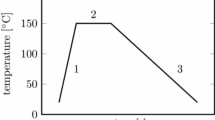Abstract
The contribution is concerned with an adaptive scheme for the finite-element square (\(\hbox {FE}^2\)) method. The \(\hbox {FE}^2\) method allows a continuous homogenization considering the current deformation state of the heterogeneous material structure. The micro-structure is represented by a representative volume element, which differs in the fiber distribution. The fiber material behavior is assumed as elasto-plastic. The non-linear response of the fiber necessitates a numerical homogenization for every load step at each integration point, which leads to an increased computational effort. An indicator for a nested \(\hbox {FE}^2\) homogenization is introduced. It takes advantage of the fact that a accompanying homogenization is only necessary in the regions of non-linear material behavior. The present work deals with an adaptive scheme for fiber–matrix composites to reduce the computational cost. Numerical examples show the capability of the proposed scheme.






















Similar content being viewed by others
References
Broughton JQ, Abraham FF, Bernstein N, Kaxiras E (1999) Concurrent coupling of length scales: methodology and application. Phys Rev B 60(4):2391
Ibrahimbegović A, Markovič D (2003) Strong coupling methods in multi-phase and multi-scale modeling of inelastic behavior of heterogeneous structures. Comput Methods Appl Mech Eng 192(28):3089
Fish J, Yuan Z (2005) Multiscale enrichment based on partition of unity. Int J Numer Methods Eng 62(10):1341
Hund A, Ramm E (2007) Locality constraints within multiscale model for non-linear material behaviour. Int J Numer Methods Eng 70(13):1613
Ortolano J, Hernández Ortega JA, Oliver Olivella X (2013) A comparative study on homogenization strategies for multi-scale analysis of materials. Centre Internacional de Mètodes Numèrics en Enginyeria (CIMNE), Barcelona
Kanouté P, Boso D, Chaboche J, Schrefler B (2009) Multiscale methods for composites: a review. Arch Comput Methods Eng 16(1):31
Voigt W (1889) Über die Beziehung zwischenden beiden Elastizitätskonstanten Isotroper Körper. Wied Ann 38(2):573
Reuss A (1929) Berechnung der fließgrenze von mischkristallen auf grund der plastizitätsbedingung für einkristalle. Z Angew Math Mech 9(1):49
Hashin Z, Shtrikman S (1963) A variational approach to the theory of the elastic behaviour of multiphase materials. J Mech Phys Solids 11(2):127
Pierard O, Friebel C, Doghri I (2004) Mean-field homogenization of multi-phase thermo-elastic composites: a general framework and its validation. Compos Sci Technol 64(10–11):1587
Eshelby JD (1957) The determination of the elastic field of an ellipsoidal inclusion, and related problems. In: Proceedings of the Royal Society of London A: mathematical, physical and engineering sciences, vol 241. The Royal Society, pp 376–396
Mori T, Tanaka K (1973) Average stress in matrix and average elastic energy of materials with misfitting inclusions. Acta Metall 21(5):571
Zohdi TI, Wriggers P (2008) An introduction to computational micromechanics. Springer, Berlin
Nemat-Nasser S, Hori M (2013) Micromechanics: overall properties of heterogeneous materials, vol 37. Elsevier, Amsterdam
Hill R (1963) Elastic properties of reinforced solids: some theoretical principles. J Mech Phys Solids 11(5):357
Gitman I, Askes H, Sluys L (2007) Representative volume: existence and size determination. Eng Fract Mech 74(16):2518
Smit R, Brekelmans W, Meijer H (1998) Prediction of the mechanical behavior of nonlinear heterogeneous systems by multi-level finite element modeling. Comput Methods Appl Mech Eng 155(1–2):181
Feyel F, Chaboche JL (2000) FE\(^{2}\) multiscale approach for modelling the elastoviscoplastic behaviour of long fibre SiC/Ti composite materials. Comput Methods Appl Mech Eng 183(3):309
Miehe C, Koch A (2002) Computational micro-to-macro transitions of discretized microstructures undergoing small strains. Arch Appl Mech 72(4):300. https://doi.org/10.1007/s00419-002-0212-2
Gruttmann F, Wagner W (2013) A coupled two-scale shell model with applications to layered structures. Int J Numer Methods Eng 94(13):1233
Schröder J, Keip MA (2012) Two-scale homogenization of electromechanically coupled boundary value problems. Comput Mech 50(2):229. https://doi.org/10.1007/s00466-012-0715-9
Gebbeken N (1996) Zur Untersuchung des linearen Tragverhaltens von Verbundkonstruktionen mittels numerischer Methoden. Technical report 96/1, Universität der Bundeswehr München
Hori M, Nemat-Nasser S (1999) On two micromechanics theories for determining micro–macro relations in heterogeneous solids. Mech Mater 31(10):667
Miehe C, Schröder J, Becker M (2002) Computational homogenization analysis in finite elasticity: material and structural instabilities on the micro-and macro-scales of periodic composites and their interaction. Comput Methods Appl Mech Eng 191(44):4971
Saeb S, Steinmann P, Javili A (2016) Aspects of computational homogenization at finite deformations: a unifying review from Reuss’ to Voigt’s bound. Appl Mech Rev 68(5):050801
Shen H, Brinson LC (2006) A numerical investigation of the effect of boundary conditions and representative volume element size for porous titanium. J Mech Mater Struct 1(7):1179
Huet C (1990) Application of variational concepts to size effects in elastic heterogeneous bodies. J Mech Phys Solids 38(6):813
Simo JC, Hughes TJ (2006) Computational inelasticity, vol 7. Springer, Berlin
Kohlhaas B, Klinkel S (2015) An FE\(^2\) model for the analysis of shape memory alloy fiber-composites. Comput Mech 55(2):421
Larsson F, Runesson K (2007) RVE computations with error control and adaptivity: the power of duality. Comput Mech 39(5):647
Fish J, Fan R (2008) Mathematical homogenization of nonperiodic heterogeneous media subjected to large deformation transient loading. Int J Numer Methods Eng 76(7):1044
Acknowledgements
We thank the German Research Foundation (DFG) for financial support under Grant Number KL 1345/9-1
Author information
Authors and Affiliations
Corresponding author
Additional information
Publisher's Note
Springer Nature remains neutral with regard to jurisdictional claims in published maps and institutional affiliations.
Rights and permissions
About this article
Cite this article
Praster, M., Klassen, M. & Klinkel, S. An adaptive \(\hbox {FE}^2\) approach for fiber–matrix composites. Comput Mech 63, 1333–1350 (2019). https://doi.org/10.1007/s00466-018-1652-z
Received:
Accepted:
Published:
Issue Date:
DOI: https://doi.org/10.1007/s00466-018-1652-z




